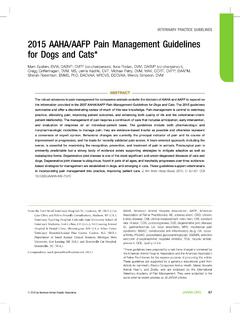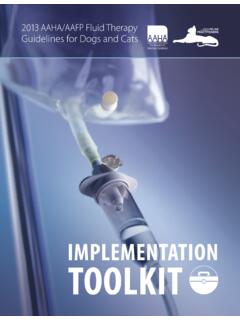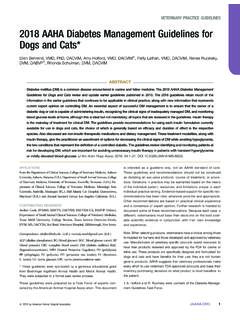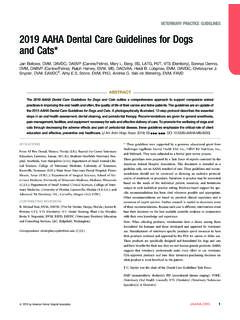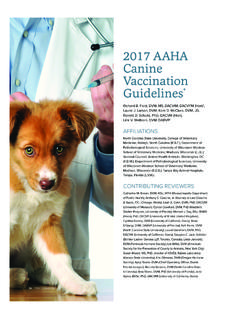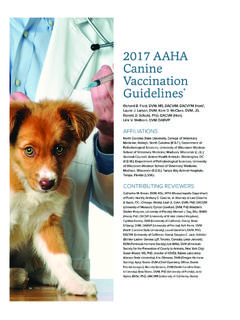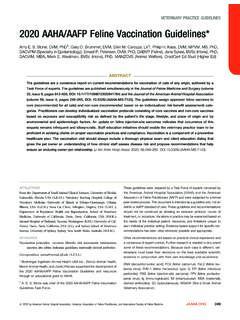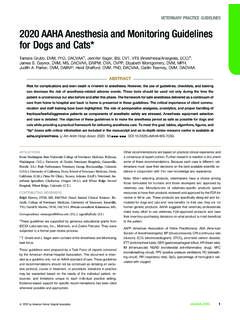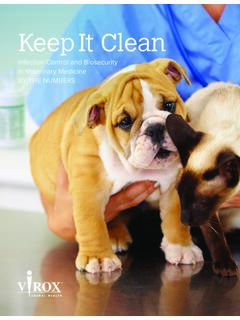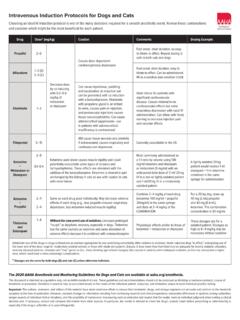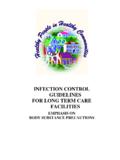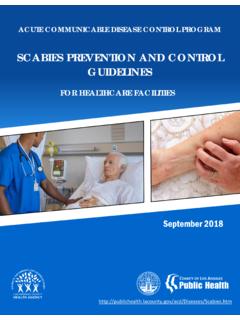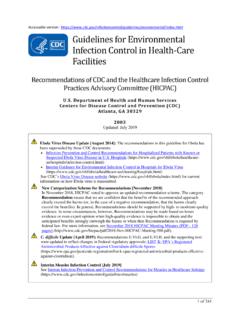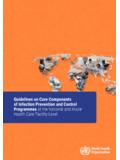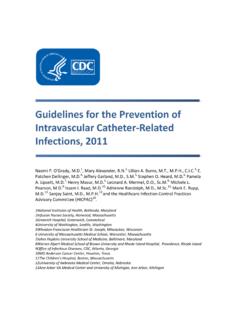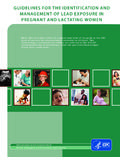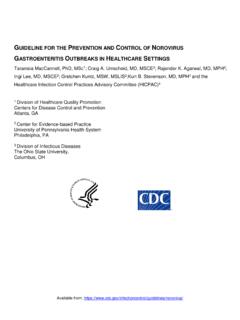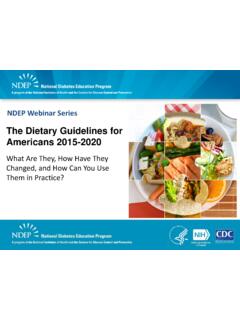Transcription of VETERINARY PRACTICE GUIDELINES 2018 AAHA Infection …
1 VETERINARY PRACTICE GUIDELINES2018 AAHA Infection control , prevention , andBiosecurity GUIDELINES *Jason W. Stull, VMD, MPVM, PhD, DACVPMy, Erin Bjorvik, BS, CVT, Joshua Bub, DVM, DABVP (C/F), GlendaDvorak, MS, DVM, MPH, DACVPM, Christine Petersen, DVM, PhD, Heather L. Troyer, DVM, DABVP (C/F), CVA,CVPPABSTRACTA VETERINARY team s best work can be undone by a breach in Infection control , prevention , and biosecurity (ICPB). Such a breach, inthe PRACTICE or home-care setting, can lead to medical, social, andfinancial impacts on patients, clients, and staff, as well as damagethe reputation of the hospital. To mitigate these negative outcomes, the AAHA ICPB GUIDELINES Task Force believes that hospitalteams should improve upon their current efforts by limiting pathogen exposure from entering or being transmitted throughout thehospital population and using surveillance methods to detect any new entry of a pathogen into the PRACTICE .
2 To support theserecommendations, these PRACTICE -oriented GUIDELINES include step-by-step instructions to upgrade ICPB efforts in any hospital,including recommendations on the following: establishing an Infection control practitioner to coordinate and implement the ICPB program; developing evidence-based standard operating procedures related to tasks performed frequently by the VETERINARY team(hand hygiene, cleaning and disinfection, phone triage, etc.); assessing the facility s ICPB strengths and areas of improvement;creating a staff education and training plan; cataloging client education material specific for use in the PRACTICE ; implementing asurveillance program; and maintaining a compliance evaluation program. Practices with few or no ICPB protocols should beencouraged to take small steps.
3 Creating visible evidence that these protocols are consistently implemented within the hospitalwill invariably strengthen the loyalties of clients to the hospital as well as deepen the pride the staff have in their roles, both of whichare the basis of successful VETERINARY PRACTICE .(JAmAnimHospAssoc2018; 54:--- ---. DOI )AFFILIATIONSFrom the Department of VETERINARY Preventive Medicine, College of Veter-inary Medicine, Ohio State University, Columbus, Ohio, and Department ofHealth Management, Atlantic VETERINARY College, the University of PrinceEdward Island, Charlottetown, Prince Edward Island, Canada ( ); Vet-erinary Specialty Center, Buffalo Grove, Illinois ( ); Mesa VETERINARY Hos-pital, Golden, Colorado ( ); Center for Food Security and Public Health,College of VETERINARY Medicine, Iowa State University, Ames, Iowa ( );Department of Epidemiology and Center for Emerging Infectious Diseases,College of Public Health, University of Iowa, Iowa City, Iowa ( ); andOradell Animal Hospital, Paramus, New Jersey ( ).
4 CONTRIBUTING REVIEWERSJ. Scott Weese, DVM, DVSc, DACVIM (Department of Pathobiology, On-tario VETERINARY College, University of Guelph, Guelph, Ontario, Canada);Jeff Bender, DVM, MS, DACVPM (Division of Environmental Sciences,School of Public Health and College of VETERINARY Medicine, University ofMinnesota, Minneapolis, Minnesota).Correspondence: ( )* These GUIDELINES were prepared by a task force of experts convenedby AAHA. This document is intended as a guideline only, not an AAHA standard of care. These GUIDELINES and recommendations should not beconstrued as dictating an exclusive protocol, course of treatment, orprocedure. Variations in PRACTICE may be warranted based on the needsof the individual patient, resources, and limitations unique to each indi-vidual PRACTICE setting.
5 Evidence-based support for specific recommen-dations has been cited whenever possible and appropriate. Otherrecommendations are based on practical clinical experience and a con-sensus of expert opinion. Further research is needed to document someof these recommendations. Because each case is different, veterinar-ians must base their decisions on the best available scientific evidencein conjunction with their own knowledge and GUIDELINES were supported by a generous educational grant fromVirox Animal Health. They were subjected to a formal peer-review (alcohol-based hand sanitizer); HAI (hospital-acquired infections );ICP ( Infection control practitioner); ICPB ( Infection control , prevention ,and biosecurity ); MDR (multidrug resistant); MRSP (methicillin-resistantStaphylococcus pseudintermedius); PPE (personal protective equip-ment); SOP (standard operating procedure); SSI (surgical site Infection ) J.
6 Stull was the chair of the Infection control , prevention , and Bio-security GUIDELINES Task Force. 2018 by American Animal Hospital and ObjectivesWithout effective Infection control , prevention , and biosecurity (ICPB) implemented in the VETERINARY primary care and referralsettings, the clinician s efforts at disease prevention and treatmentare compromised and, in some cases, nullified. Thus, ICPB is atthe heart of the veterinarian s pledge to protect animal health andwelfare and public health, as well as the universal mandate amongthe healing professions to first, do no harm. Hospital-acquiredinfections (HAI), sometimes referred to as nosocomial infections ,are an inherent risk in human and VETERINARY medicine, andbreaches in ICPB can have direct and indirectfinancial, social,and environmental impacts on patients, clients, and staff.
7 In apractical sense, any practitioner who doubts the value of ICPB need only experience a client sdispleasure,ananimal s healthcomplications, or the consequences of an unflattering online re-view when a pet contracts infectious enteritis or respiratory dis-ease during boarding or hospitalization or requires postsurgicaltreatment due to an fact is, our best work can beundone by an Infection control breach in the PRACTICE or home-care setting. The AAHA Infection control , prevention , andBiosecurity GUIDELINES are thefirst clinician-focused and PRACTICE -oriented GUIDELINES on this topic developed specifically for use incompanion animal medicine. As such, these GUIDELINES comple-ment the growing emphasis in human medicine on infectioncontrol to prevent HAIs and exposure of patients and workers toinfectious pathogens in the PRACTICE or laboratory and build offexisting VETERINARY best PRACTICE and topic-focused 7 The increasing involvement of drug-resistant pathogens such asmethicillin-resistant staphylococci in HAIs has created addi-tional urgency for effective ICPB.
8 Adding to the risk associatedwith ICPB lapses is the potential for in-hospital exposure tozoonotic diseases such as leptospirosis, rabies, salmonellosis,campylobacteriosis, and infections with ecto- and endoparasites( ,fleas, ticks, and helminths). Taken together, these factorscreated a strong motivation to assemble a task force of experts toproduce these ICPB many HAI likely occur unnoticed, solely relying upon theawareness of outbreaks as a measure of effective ICPB practicesresults in a false sense of security and unnecessary patient andstaff health risks. As such, effective ICPB is dependent on thedevelopment of and adherence to standardized processes andprotocols followed by self-audit and protocol adjustment. Theseguidelines provide a conceptual roadmap and specific, practicalguidance on how to institute and evaluate ICPB standard operatingprocedures (SOPs) that will safeguard patients, staff, and clientsfrom avoidable exposure to infectious pathogens.
9 It is importantto acknowledge that not all HAI will be prevented by followingICPB SOPs; however, studies indicate 10 70% of all HAIs inhuman medicine are preventable by using practical infectioncontrol measures, an estimate that is likely applicable to veteri-nary on patient health, owner cost, and owner and staff the various protocols specified in these guide-lines or provided as online resources may seem daunting , most practices already effectively apply many infectioncontrol procedures as an aspect of sound clinical PRACTICE . Theseguidelines will nevertheless help any primary care or referralpractices to systematize and strengthen their existing ICPB protocols and enlist the entire healthcare team in this essentialaspect of high-quality VETERINARY care.
10 To that end, the guidelinespresent a progression of interventions from most to least , VETERINARY practices can implement the recommen-dations of the ICPB task force incrementally without beingoverwhelmed by attempting an immediate, complete overhaul ofICPB ICPB principles become part of a PRACTICE sculture,thehealthcare team can more confidently admit and treat all patients,including those with emerging or endemic infectious diseases,while minimizing the risk of exposing other patients, staff,and clients. An effective approach, strongly recommended bythe ICPB task force, is to appoint a PRACTICE champion whotakes primary responsibility for implementing ICPB proto-cols and ensuring staff compliance. This individual should fo-cus on the two principal components of ICPB, which are to(1) limit pathogen introduction, exposure, transmission,and Infection within the hospital population.
